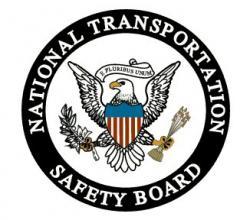Sat, Mar 01, 2008
Cites Possible Maintenance Error In Connecting Antiskid
Sensors
 In its continuing investigation of
an incident in which a United Airlines Airbus A320 departed the
runway during landing at Wyoming's Jackson Hole
Airport on the evening of February 25, the
National Transportation Safety Board (NTSB) has developed the
following factual information during its on-scene
investigation.
In its continuing investigation of
an incident in which a United Airlines Airbus A320 departed the
runway during landing at Wyoming's Jackson Hole
Airport on the evening of February 25, the
National Transportation Safety Board (NTSB) has developed the
following factual information during its on-scene
investigation.
Investigators with the safety board have determined the airplane
came to rest 116 feet past the end of the runway, and 140 feet to
the right of the runway centerline. A heavy skid mark was found on
the runway associated with the inboard tire of the left main
landing gear. This tire was found deflated and showed wear
consistent with a skid. Upon exiting the runway, both engines
ingested snow and sustained internal damage. The aircraft itself
was not substantially damaged.
Examination of the left main landing gear brakes revealed that
the inboard and outboard wheel speed tachometer wires were
cross-connected. Such a configuration would be likely to cause the
antiskid system to use the inboard wheel speed to control the
outboard braking, and vice versa. In such a situation, it would be
likely that when the inboard tire began to skid, the antiskid
system would release the pressure on the outboard brake instead of
the inboard brake.
Examination of maintenance records indicated that both main landing
gear units were replaced on the incident airplane in early February
2008. The Safety Board is also investigating another United A320
incident with similar circumstances that occurred on October 9,
2007.
Another area of the investigation is the inoperability of one of
the emergency evacuation slides. The slide at the front left door
deployed when the door was opened during the evacuation but did not
inflate. The manufacturer of the slide will assist the NTSB in its
investigation of the cause of the failure.
Information obtained from the flight data recorder (FDR) and the
cockpit voice recorder (CVR) is being analyzed at the Safety
Board's laboratory in Washington.
Investigators are continuing to gather factual information in
aircraft performance, human factors and other areas.
More News
Pilot Applied Full Aft Stick And Nose-Up Trim, But The Airplane Remained On The Runway Analysis: The pilot reported that a preflight inspection and flight control checks revealed n>[...]
A Few Questions AND Answers To Help You Get MORE Out of ANN! 1) I forgot my password. How do I find it? 1) Easy... click here and give us your e-mail address--we'll send it to you >[...]
From 2022 (YouTube Edition): Before They’re All Gone... Humankind has been messing about in airplanes for almost 120-years. In that time, thousands of aircraft representing i>[...]
Advanced Air Mobility (AAM) A transportation system that transports people and property by air between two points in the NAS using aircraft with advanced technologies, including el>[...]
Aero Linx: MQ-1B Predator The MQ-1B Predator is an armed, multi-mission, medium-altitude, long-endurance remotely piloted aircraft that is employed primarily as an intelligence-col>[...]
 NTSB Final Report: Douglas A-4K
NTSB Final Report: Douglas A-4K ANN FAQ: Q&A 101
ANN FAQ: Q&A 101 Classic Aero-TV: PBY Catalina--From Wartime to Double Sunrise to the Long Sunset
Classic Aero-TV: PBY Catalina--From Wartime to Double Sunrise to the Long Sunset ANN's Daily Aero-Term (07.01.25): Advanced Air Mobility (AAM)
ANN's Daily Aero-Term (07.01.25): Advanced Air Mobility (AAM) ANN's Daily Aero-Linx (07.01.25)
ANN's Daily Aero-Linx (07.01.25)



